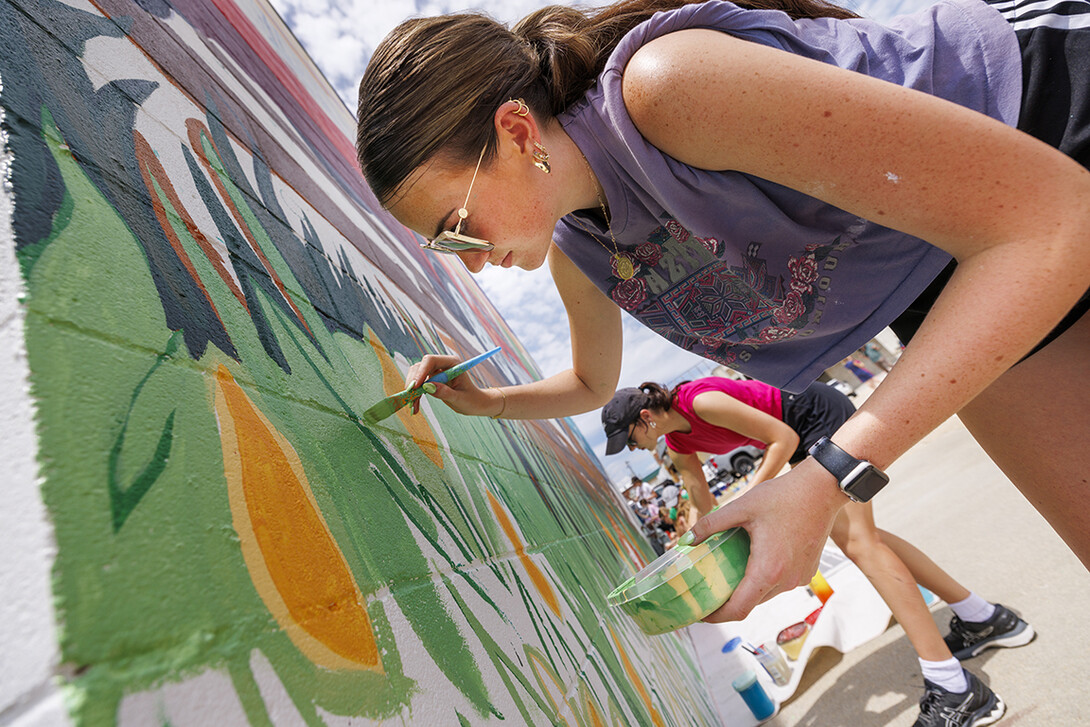
Students enrolled in a Fine and Performing Arts course have added a new roadside view along U.S. Highway 77 in Beatrice.
The group — part of a Street Art II: Mural Masters class led by Sandra Williams, associate professor of art — spent more than a week painting a mural at Premier Chevrolet Buick GMC in Beatrice. Williams said project offers students valuable experience while connecting them to Nebraska communities. It also offers students a creative experience that cannot be replicated in a classroom.
“I’m a fan of pairing real world skills with academic objectives, that one should reflect the other,” she said. “The most significant learning experiences I had as a student were when I was working with other people. That is the real foundation of education that was valuable to me, so I always look for ways to provide that opportunity for students.”
Williams has worked on public art projects in Alliance, Nebraska, for the last few years, and said they were listening to what communities wanted what the people in communities like these wanted when it came to public art.
The answer? Murals.
“Nebraska towns are a blank canvas waiting for renewal,” Williams said. “Murals can revitalize spaces. They can catalyze broader community ideas into renewal initiatives. There are educational, social and economic benefits to having widespread cultural access.”
As the Nebraska Extension engagement zone coordinator in southeast Nebraska, Karly Black’s job is to help iron out the coordination and facilitate collaboration between rural communities and different departments at the university—in this case the School of Art, Art History and Design.
“This project allows the college students to gain new skills that they can utilize in their jobs outside of college,” she said. “They’re working with the business that is helping sponsor this mural, creating the mural, budgeting, working on this youth component, and doing community outreach. These could all be things that maybe they’re going to do in the real world.”
Andrea Schafer, chief business officer at Premier Chevrolet Buick GMC, said they were interested in a mural to beautify their building. The business sits near downtown Beatrice, which was named a Certified Creative District by the Nebraska Arts Council. Even before the mural was completed, Schafer had received messages about how excited they were about the project.
“We were able to piggyback on what their idea was and bring more art to downtown,” she said. “It makes our community look that much better.”

The staff at the business generated a concept about bringing together past and present trucks for the mural, which Schafer shared with the class. She said working with the students was easy and seamless.
“They have great ideas, and it’s fun to hear what they have to say,” Schafer said. “I love their creativity.”
They eventually selected the design of Maddie Vanderbur, who just completed her junior year in graphic design. It depicts a modern truck and an antique truck sitting next to each other in green rolling hills with wildflowers.
“I really wanted to focus on having a Nebraska landscape in the back,” Vanderbur said. “Our skies and the clouds are so beautiful here.”
Vanderbur had never been involved with a project of this scale before, she said, and she learned more about working with such a large space, adjusting to the environment and using materials like exterior paint and rollers. All students in the class also had to get aerial lift certified in order to paint the top reaches of the building.
Roadside Attraction by University of Nebraska–Lincoln on Exposure
Vanderbur said the process was extremely collaborative, and she enjoyed the opportunity to work with other students. She said she felt getting input from each other made the final product the best it could be.
“You second guess yourself sometimes, and getting another person’s opinion is really nice,” Vanderbur said. “That’s what so cool about this project, is everyone’s working on it. There’s a little piece of all of us in there.”
Williams said that collaboration is good preparation for when they have to move through various circles and types of work as professionals. The training gave students skills they will need if they want to work with communities on projects like this in the future, Williams said, and open their eyes to ways they can find careers as artists after they complete their education.
“You’re one person when you’re interacting with your gallery dealer,” Williams said. “If you’re designing for an airport, you’re on a team with engineers and urban planners. You’re never operating by yourself.”







